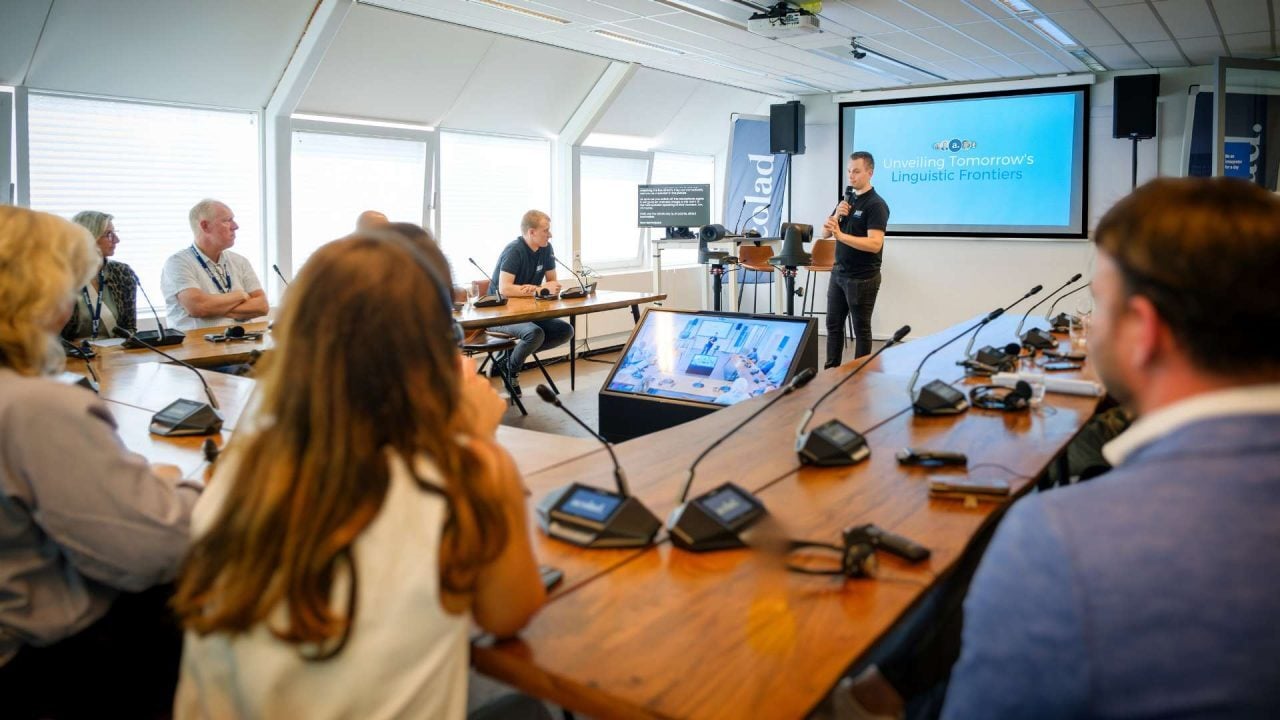Interpreting technology is advancing quicker than ever – here our Head of Interpreting Solutions Giulia Silvestrini looks at how interpreting is set to evolve and how it can balance AI with the human touch.
International conferences, cross-border business negotiations, press conferences, academic meetings and more. There are many situations where speakers of different languages come together, whether in person or on a conference call. But what use is the event if those participating can’t fully understand and participate when they may speak a different language? The solution? Interpreting.
Hiring an interpreter so that all participants can speak and listen in their native language is the best way to guarantee effective communication.
Who is Equipped to Provide Interpreting Services?
Choosing a professional interpreter has many advantages. Interpreting is a skill developed with thorough training and a lot of practice. It’s mentally demanding and requires a high level of concentration.
Professional interpreters are experts in capturing every detail in the speech they are interpreting, following the correct protocol to ensure their service is unbiased and confidential. Another key advantage is that professional interpreters specialize in particular areas, meaning they will come equipped with the specific vocabulary required for your event.
Professional language service providers can adapt their services to meet your needs, meaning you can choose between various types of interpreting, and whether it’s onsite interpreting or remote interpreting. On top of this, professional language partners are often equipped with dedicated platforms for interpreting remotely. Alternatively, they can work with whichever platform you normally use.
Some providers offer AI interpreting. This emerging technology is well-suited to certain types of events or conferences – it works particularly well for single speakers or can be economically viable when you need interpreting for difficult-to-find target languages.
For example one pharmaceutical company made the most of AI Interpreting to cut costs by 75% and deliver more languages at a major project launch.
What Are the Different Types of Interpreting Services?
There are four main types of interpreting available:
Simultaneous Interpreting
Working from a booth with a headset, the interpreter relays the message as they hear it spoken, often at a large international conference. If simultaneous interpreting is needed in more than one target language, multiple interpreters can work in separate booths at the same time.
- Most suitable for large events/audiences
- Use of headsets (for interpreter) and earpiece (for audience)
- Allows for interpreting into multiple languages at the same time
Consecutive Interpreting
When interpreting consecutively, the interpreter takes notes while the speaker delivers a section of their message and then relates the message in the target language to the audience.
- Most suitable for small meetings
- Can be used when interpretation is only needed from one source language into one target language
Liaison Interpreting
The key difference with liaison interpreting is that the interpreter conveys the message phrase by phrase between the two languages.
- Most suitable for very small business meetings or negotiations
- Allows for a two-way exchange between two languages
Whispered Interpreting
Whispered interpreting is similar to simultaneous in that the interpreter relays the message as it is being spoken. However, as the name suggests, they speak in a low voice into the client’s ear.
- Most suitable when only one person needs interpretation
- The message is uninterrupted
All four interpreting types can be used onsite and all but whispered interpreting can be used remotely.
What About Remote Interpreting?
If your meeting or event is taking place as a conference call, whether over the phone or via video link, there are interpreting solutions available to suit your needs.
Simultaneous Interpreting
- One or multiple target languages
- No interruption for the speaker
Simultaneous interpreting is supported by some video conferencing software. Alternatively, a specially designed interpreting platform can be provided by the interpreter.
Consecutive Interpreting
One target language
Speaker and interpreter take turns
- If you require remote consecutive interpreting, this can be done by simply using your normal video conferencing software, such as Zoom, Teams, Webex, etc.
Liaison Interpreting
- Two languages, both directions
- One-on-one meetings
As with consecutive interpreting, an interpreter can join your online meeting to provide a liaison interpreting service.
Up-to-date technology allows for the same high-quality service, whether the interpreter is onsite or working remotely. Many language service providers can set up the technical aspects of remote interpreting, including testing the audio before the event. Good sound quality is essential for good interpreting. A technician can be available during the meeting and they can record the meeting for you, leaving one less thing to worry about.
Remote interpreting has some advantages. It saves on costs, while a remote interpreter can even be available immediately to assist with last-minute meetings or to cover unforeseen circumstances.













